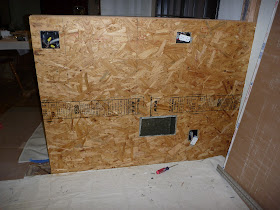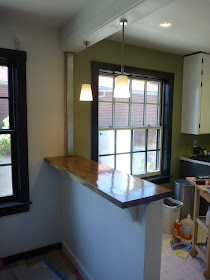Despite
what a lot of people told me, a 22.5" deep Bosch dishwasher will fit under some shallow cabinets that were standard on older houses.
Bosch's specs
claim the unit has a 22.5" depth (with door) but everyone I talked to (at Lowe's and
even Bosch) told me it needed the standard 24"W x
34"H x 24"D opening because the 22.5" dimension didn't include the door
or that
it needed room for the waste hose but that's not necessarily
true. After checking various engineering drawings and specs I found on Bosch's European sites, I took a gamble (after making sure I could return it if it didn't fit of course)
and it paid off. This unit fits quite well in my shallow 1940's 20.5"
deep cabinets and it doesn't stick out any more than most other brand
dishwashers installed in standard depth cabinets do.
Keep in mind this older style kitchen doesn't have "drywall" installed behind the cabinets so I had a little bit more depth under the counter than you would measure on top of the counter, if that makes sense. The cabinets were actually installed to the wood studs, then "drywall" was installed around them. But seeing as you've made your way to this page, I'm guessing your cabinets are installed in a similar manner.
So anyways, people with old houses and no cash for new cabinets/counters can rejoice because most Bosch units (with a claimed 22.5" depth) will fit without sticking out too much. Remember to do your homework though and check the technical drawings for your particular model and make sure you can return the unit if it doesn't fit. Also, if you'd like to read my thoughts on the dishwasher itself, you can find my review here.
Update: my model isn't available anymore but Bosch has pretty good drawings on their spec sheets showing the true depths:
http://www.bosch-home.com/us/products/dishwashers/built-in-dishwashers/all-dishwashers.html
Anything with a 22-7/16" depth is the same as mine and can be pushed all the way back as long as your drain hose can exit out the left or right side (under that little overhang) as shown by the arrow:
As you can see it still sticks out a little but I find it looks intentional and not out of place. The top of the control panel is actually a small bit recessed under the counter. Also, since doing this install I've been paying more attention to other peoples' dishwashers and I've noticed even under full size 25" counters, most dishwasher stick out at least as much as mine.
Here are some random pictures showing the install. Sorry for the lack of a real writeup. And if you're a cabinet maker, sorry for all the cringing that will ensue from looking at how I did this...
Pretty freakin' ugly.
Looks like the previous owner was cool with a poorly caulked sink. Thanks, Dick.
Looks like Dick was here...
Here you can see how the cabinets on old houses (well, mine at least) were installed right up against the wall studs. Luckily, this gives you a little bit more room to shove the dishwasher back.
An oscillating tool (Dremel Multi-Max) is probably the most versatile tool you can own
I put down a piece of laminate that was ever so slightly angle up in the back so that if the dishwasher ever leaks, it'll leak out the front and I'll see it.
Don't laugh at my ghetto cabinet walls.
Hope this helps. Let me know if you have any questions.




























































